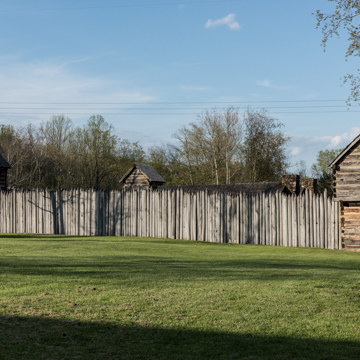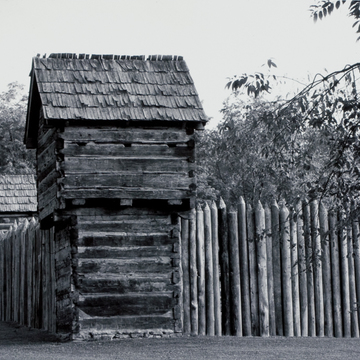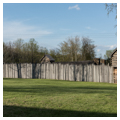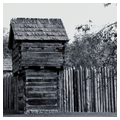This carefully researched reconstruction of one of the state's earliest forts illustrates a vital component of pioneer life in northwestern Virginia. Captain Jacob Prickett built the original fort, overlooking the Monongahela River, in 1774. Like other frontier defenses, it was not intended as a place for daily living, but as a refuge whenever the threat of Indian attack seemed imminent. When the call was given, settlers hastily fled their own homes to assemble in the fort. Prickett's served as a military post during the Revolution and was dismantled in 1799 after the threat of Indian raids disappeared. As early as 1927, the state attempted to purchase and protect the site, but it was not until 1966, when the U.S. Army Corps of Engineers acquired the property and constructed a boat launching ramp nearby, that interest was again aroused. In 1970 the Pricketts Fort Memorial Foundation was formed, and by 1973 rebuilding had begun. In 1975 the state appropriated funds to complete the project for the U.S.
The square palisade, with 12-foot-high stockade walls, measures 450 feet on each side. Twostory log bastions, their upper stories projecting 2 feet and equipped with slats enabling defenders to fire on attackers directly below, guard the four corners. Within the enclosure, sixteen tiny shed-roofed cabins with log chimneys and dirt floors stand tight against the outer walls. A larger meeting hall and storehouse have been reconstructed near the center of the enclosure. Logs salvaged from early houses in the area were used for the reconstruction. The published recollections of Stephen Morgan, who assisted in building the original fort, helped guide the restoration. The plan is also similar to a generic type that Joseph Doddridge described in 1824 in his Notes on the Settlement and Indian Wars of the Western Parts of Virginia and Pennsylvania. A booklet describing the reconstruction notes with commendable candor: “whether the Memorial fort looks like Pricketts, or any other fort in the area, it is presented without apology as a monument to the crude bastions in the wilderness of Colonial Virginia when the frontier life was fraught with hardships and danger.”
The Job Prickett House, a restored two-story brick farmhouse that dates from 1859, stands just south of the re-created fort. Built by a greatgrandson of Captain Jacob Prickett, it is also open to the public and provides an instructive lesson in changes brought by less than a century of settlement. The Prickett cemetery, dating from 1772 and the area's oldest burial ground, is near the fort and house.

















